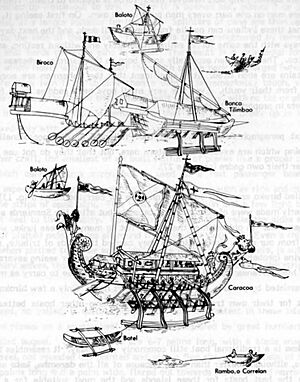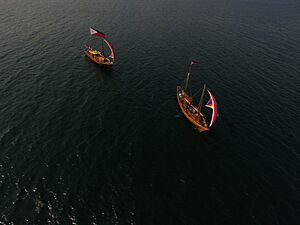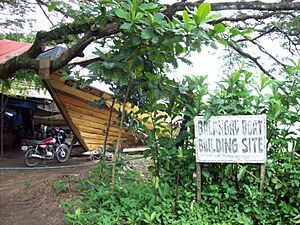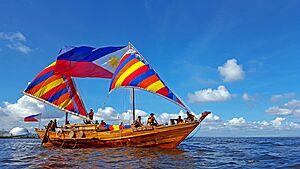Balangay facts for kids
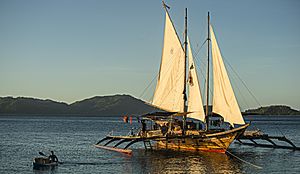
A balangay (also spelled barangay) is a special type of boat built by joining wooden planks together. Builders used pins, wooden pegs, and strong fiber ropes to create these boats. Balangays were used all over the Philippines, mostly as trading ships, until the Spanish colonial times.
The oldest balangays ever found are called the Butuan boats. There are eleven of them, and scientists have used carbon dating to find out they were built between 689 CE and 988 CE. They were found in different places in Butuan, Agusan del Norte. These Butuan boats are the largest collection of ancient boats built with this "lashed-lug" method, which was common in Austronesian boatbuilding. They were found with many trade items from places like East Asia, Southeast Asia, and even as far as Persia, showing that these boats traveled to the Middle East.
Balangays were the first wooden boats found by archaeologists in Southeast Asia. Today, the city of Butuan celebrates these amazing boats every year with the Balanghai Festival.
Contents
Names of the Balangay
The word balangay was one of the first local words that Europeans learned in the Philippines. In 1521, a writer named Antonio Pigafetta, who was with Ferdinand Magellan, wrote about these boats, calling them balangai or balanghai. This word, balangay or barangay, means the same thing in most major languages of the Philippines.
Over time, because of Spanish influence, the way barangay is said changed. But Pigafetta's old spelling, balanghai, later led to a new, slightly different word, balanghay, in the 1970s.
The Tagalog people also used the word barangay to mean the smallest group of people or a village. This is why today, many villages in the Philippines are called barangays. Spanish and American records often called the boats barangayan to tell them apart from the villages.
In Northern Luzon, the Ibanag people called their balangay boats barangay, and sometimes even the crew members were called that. Bigger boats were known as biray or biwong.
In the Visayas and Mindanao regions, these types of boats had many names, like baloto, baroto, biray, lapid, and tilimbao (or tinimbao). Balangays that carried cargo, with high sides and no outriggers, were called bidok, birok, or biroko in the Visayas. The karakoa, a large Visayan warship, was also a type of balangay.
History of the Balangay
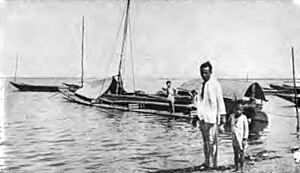

Balangay is a general word for several kinds of traditional boats used by different groups in the Philippines. It often refers to the balangay boats from the Visayas and Mindanao islands, which were mainly used for trading between islands, carrying goods, and as warships.
Large balangays, especially warships like the Butuan boats, often had big double-outriggers. These outriggers helped support platforms for paddling and fighting. These boats could also be called paraw or tilimbao. Balangay warships, along with the bigger karakoa, were used by Visayan warriors for raiding. Some believe these might have been the "Pi-sho-ye" raiders who attacked Chinese settlements in the 12th century.
An old book from around 1590, called the Boxer Codex, described these boats: "They (Visayans) have many kinds of ships for wars and voyages. Most of the ones for wars are small; they are called barangay. If they are a little bigger, they are called biray. These are very long and narrow, seating 50 to 100 rowers. Their oars are not tied to the boat; instead, the rowers gently use them with both hands. These boats are very fast. They have two or three rows of rowers on each side. These rows are placed on outriggers, which are made of large bamboo. These outriggers are on the outside of the boat, where the rowers sit comfortably. These boats travel very safely with outriggers because they cannot tip over, and they can travel in rough seas because the boat is lifted above the water. The waves hit the outriggers, not the boats. They have round sails like ours."
The book also mentioned: "They have other ships called birocos, which are much larger. Some can carry 500 or 600 baskets of wheat. They also have oars, but they are very long and tied to the ship like ours. These are their biggest boats."
In Tagalog areas, balangays were used for similar purposes but were built differently. Their planks were "sewn" together with fibers, not just dowels.
In Cagayan in Northern Luzon, the Ibanag people used balangays mainly on the Cagayan River. Sometimes, they used them for coastal trade, reaching the Ilocos Region. These were mostly cargo and fishing boats, smaller and shallower than other balangays.
Marina Sutil
From the 1700s to the 1800s, balangays were also used as warships to protect coastal villages from raiders. These defense fleets of balangay and vinta boats were called the Marina Sutil, meaning "Light Navy" or "Defense Navy." They were first organized in 1778. These boats were lightly armed but very fast, which made them perfect for quickly responding to attacks.
Brave leaders like Don Pedro Estevan and Julián Bermejo commanded these defense groups. They won several important naval battles against raiders. A big victory was the Battle of Tabogon Bay in 1818, where combined fleets defeated about forty enemy warships. This victory helped reduce the raids significantly.
How Balangay Were Built
Balangays were built using a special method called "lashed-lug." This means the planks were joined edge-to-edge. The front (prow) and back (stern) parts were made from single carved pieces of wood. The main planks came from the strong inner part of trees. Builders preferred trees like doongon, lawaan, tugas, and barayong. Traditionally, trees were cut on a moonlit night, following local beliefs. The planks were shaped using tools like adzes. The master boat builder was called a pandáy.
The first part built was the keel, which is the bottom backbone of the boat. For most Austronesian ships, the keel was actually a bangka, a boat carved from a single log. The Butuan balangay boats were a bit different because they didn't have a true keel. Instead, they had a central plank with special bumps (lugs) for tying ropes.
The outer shell of the boat was built first by attaching planks to each side of the keel. These planks were carefully shaped to curve correctly. They were held in place with wooden pegs (dowels) about 19 cm (7.5 inches) long, inserted into holes drilled into the edges of the planks. After the hull was put together, it was left to dry for a month or two.
After drying, the hull was taken apart and checked. Then, it was put back together very carefully in a stage called sugi ("matching"). The gaps between the planks were filled with fine palm fibers and sealed with a sticky resin paste. The dowels were also made more secure by hammering in small pegs called pamuta.
The next step was called os-os or us-us. This involved tying the planks very tightly to wooden ribs using fiber or rattan ropes. The ropes were tied to special bumps (tambuko) on the inside of the planks. Wedges were then driven between the ribs and planks, making the ropes even tighter. Crossbeams were then placed across the hull and also tied down, then covered with removable wooden floors. Once finished, a hull was usually about 15 meters (49 feet) long and 4 meters (13 feet) wide.
The masts and outriggers of the ancient balangay boats were not found, which is why modern copies sometimes don't have them. However, it's believed they had large outriggers, which would be needed for them to use sails without tipping over. Outriggers made the boats much more stable and powerful with sails. In large war balangays, outriggers also supported platforms for paddling and fighting.
Similar boat-building skills are still used today by the Sama-Bajau people in Sibutu Island in Tawi-Tawi.
The Butuan Boats
The Butuan balangay boats were the first wooden boats found by archaeologists in Southeast Asia. They were discovered in the late 1970s in Butuan, Agusan del Norte. Locals accidentally found nine wooden boats while looking for gold near the Masao River. The site was in an old, dried-up river channel. Since then, at least eleven boats have been found there. Each boat is named based on the order it was discovered.
Seven of the eleven balangays (Butuan Boats 1, 2, 3, 4, 5, 7, and 9) have been or are being dug up by the National Museum. Only three (Butuan Boats 1, 2, and 5) have been fully recovered and are on display. The wood used for the boats came from trees native to the Philippines and nearby Southeast Asian regions. Modern dating methods show they were built between the 7th and 10th centuries CE.
- Butuan Boat 1 - Found in 1976. It was about 10.2 meters (33.5 feet) long and dates from 777-988 CE. It's now at the National Museum of the Philippines in Butuan City.
- Butuan Boat 2 - Found in 1977. It was about 11.3 meters (37 feet) long and is the oldest, dating from 689-940 CE. It's stored at the National Museum of Anthropology in Manila.
- Butuan Boat 4 - Started being dug up in 2012. It dates from around 775-973 CE.
- Butuan Boat 5 - Found in 1985-1986. It was about 11.5 meters (37.7 feet) long and dates from around 776-971 CE. Parts of it are displayed at the National Museum in Butuan.
- Butuan Boat 9 - Started being dug up in 2012. It's the biggest balangay found, sometimes called the "mother boat," about twice as long as the others. It dates from around 773-968 CE.
Digging up the Butuan Boats has been challenging. Early excavations in the 1970s and 1980s didn't have good records or ways to preserve the boats. Some excavations were stopped because the boats were in very poor condition. As of 2022, the remaining boats are still in their original waterlogged condition, which is the best way to keep them safe.
The Butuan boats are the largest group of ancient "lashed-lug" boats from the Austronesian boatbuilding traditions. They were found with many trade items from places like China, Cambodia, Thailand, Vietnam, and even Persia, showing that these boats traded as far as the Middle East.
Important Declarations
National Cultural Treasures
The balangays of Butuan were declared "National Cultural Treasures" by President Corazon Aquino on March 9, 1987. This means they are very important historical and cultural items for the Philippines. The areas where they were found were also made archaeological reserves.
National Boat
In November 2015, the Balangay was chosen to be the "National Boat of the Philippines" by the House Committee on Revisions of Laws. This was done so that future generations of Filipinos would remember the important role their ancestors played in shaping the country's sea traditions. It also helps remember values like working together, harmony, determination, courage, and bravery.
There is a bill, House Bill 6366, that officially proposes the Balangay as the National Boat of the Philippines.
The Balangay Voyage
In 2009, the Kaya ng Pinoy Inc. team, who climbed Mount Everest in 2006, announced plans to rebuild a balangay boat. They got help from Sama-Bajau people and other tribal members who still knew the old boat-building techniques. The idea was for the balangay to sail the same routes that ancient Filipino Ancestors took when they settled across Maritime Southeast Asia and the Pacific. The special wood for the boat came from traditional sources in Tawi-Tawi. The team found Sama-Bajau master boat builders who used traditional tools to build the boat at Manila Bay.
The balangays, named Diwata ng Lahi, Masawa Hong Butuan, and Sama Tawi-Tawi, sailed without modern instruments. They used only the traditional skills of the Filipino Sama people, navigating by the Sun, stars, wind, clouds, waves, and bird movements. The voyage aimed to remind people of the greatness of their ancestors.
The first part of the journey covered 2,108 nautical miles (3,908 kilometers) around the Philippines, stopping at many cities to promote the project. The second part of the voyage (2010–2011) took the balangay boats around South East Asia, visiting Brunei, Indonesia, Malaysia, Singapore, Cambodia, Thailand, and Vietnam before returning to the Philippines.
In 2019, the Balangay Voyage team announced that two more balangays (Lahi ng Maharlika and Sultan sin Sulu) would sail on December 14, 2019. They planned to go from Palawan to Butuan, then to Mactan, to celebrate the 500th anniversary of the Battle of Mactan.
Balangay Site Museum
The Balangay Site Museum, also known as "Balanghai Shrine Museum," holds the balangays found from 320 AD. It's located in Sitio Ambangan, Barangay Libertad, Butuan. The museum also shows other items found with the boats, like human and animal remains, jewelry, coffins, and pots. The museum was built in 1979 after a local resident donated the land.
Balanghai Festival
In Butuan, Agusan del Norte, the annual Balanghai Festival celebrates how the city was settled by people arriving in balangay ships.
See also
- Avang
- Bangka (boat)
- Falua
- Garay (ship)
- Guilalo
- Karakoa
- Lancaran (ship)
- Lepa (ship)
- Paraw
- Vinta



